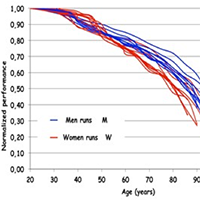Gender difference of aging performance decay rate in normalized Masters World Records of Athletics: much less than expected

Submitted: 3 February 2020
Accepted: 11 February 2020
Published: 1 April 2020
Accepted: 11 February 2020
Abstract Views: 921
PDF: 494
HTML: 29
HTML: 29
Publisher's note
All claims expressed in this article are solely those of the authors and do not necessarily represent those of their affiliated organizations, or those of the publisher, the editors and the reviewers. Any product that may be evaluated in this article or claim that may be made by its manufacturer is not guaranteed or endorsed by the publisher.
All claims expressed in this article are solely those of the authors and do not necessarily represent those of their affiliated organizations, or those of the publisher, the editors and the reviewers. Any product that may be evaluated in this article or claim that may be made by its manufacturer is not guaranteed or endorsed by the publisher.
Similar Articles
- Sandra Zampieri, Ines Bersch, Piera Smeriglio, Elena Barbieri, Simona Boncompagni, Maria Chiara Maccarone, Ugo Carraro, Program with last minute abstracts of the Padua Days on Muscle and Mobility Medicine, 27 February – 2 March, 2024 (2024Pdm3) , European Journal of Translational Myology: Vol. 34 No. 1 (2024)
- The Editors, Abstracts of the 2017 Spring Padua Muscle Days: Translational Myology for Impaired Mobility | Euganei Hills, Padua, Italy, March 23-25, 2017 , European Journal of Translational Myology: Vol. 27 No. 2 (2017)
You may also start an advanced similarity search for this article.

 https://doi.org/10.4081/ejtm.2019.8869
https://doi.org/10.4081/ejtm.2019.8869



